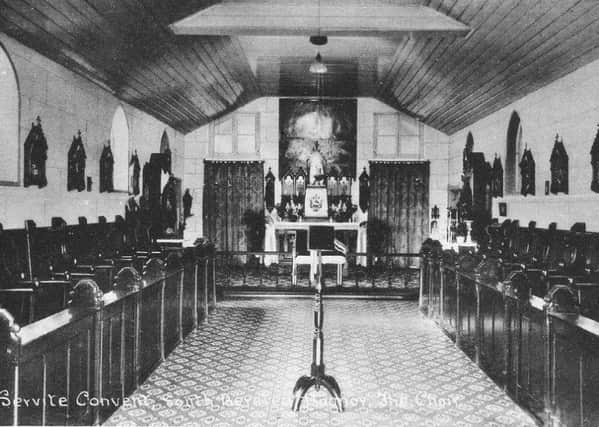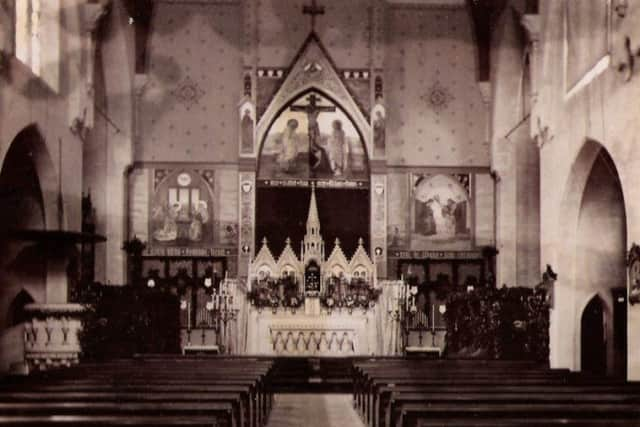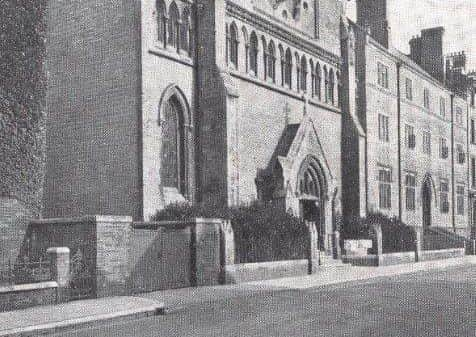Nostalgia: Joy of the Sorrows church


Today I am going to look at ‘Our Lady of Sorrows Church’ in Clarence Road – the home for the town’s Roman Catholics.
The church is dedicated to Our Lady of Seven Dolours. Prior to the arrival of the Servites into the town Catholics had to travel either to Chichester or Arundel for Mass.
Advertisement
Hide AdAdvertisement
Hide AdThe Servite Fathers were first invited into England, from Italy in 1864 by Cardinal Wiseman to establish a foundation in Fulham London. Within 16 years they were invited to establish their second foundation here in Bognor.


In all my readings, notes and information I have been unable to ascertain the specific reason for their choosing Bognor, compared with other suitable places within the diocese.
It is reported that an Italian priest was apparently walking up and down a London Street begging for money to build this new church and he called on a Miss Susan Walker who donated £5,000, with a promise of more money in the future.
Unfortunately she died before the church was completed and thus further donations were not forthcoming from her.
Advertisement
Hide AdAdvertisement
Hide AdInitially Father Simony and Father Melani arrived during November 1880, staying at ‘Canonbury’, a boarding house on the seafront. Other fathers stayed at No 10 London Road during their stay in the town, Sport’s Direct now occupies this site.


Their first task was to open a school for Catholic children in Sudley Road. Further visits to the town found a room, to serve as a public chapel, which was in Argyle Circus, while the church was being constructed.
This temporary meeting place was opened on June 26, 1881.
Within 12 months, work commenced on the new church, which was to be constructed in a field known as Clarence Meadows, thus having the frontage to Clarence Road. On October 26, the foundation stone was laid, and under the foundation stone a bottle was placed, which held an inscribed parchment and a current coin of the realm.
For this ceremony, the Very Rev Canon Butt of Arundel, arrived at Bognor station at 1pm. Travelling with him were numerous fathers and other people devoted to the Servite Order. They formed a long procession to the new site.
Advertisement
Hide AdAdvertisement
Hide AdOn their arrival they found a large cross had been erected, alongside a Union Jack and Papal flag flying high above the site. A builder’s shed had ‘been suitably garnished to be used as a robe room for the clergy’.
Interestingly, the large crowd was reported as containing many ‘non-Catholics’. The population of the town at this time was shown on the census as being 3,290.
A formal opening day was held on August 16, 1882, although the church was incomplete.
Cardinal Lepicir arrived for the opening, but he recalled that when he first arrived in Bognor, he had come ‘out of the fog and noise of the Metropolis into the beautiful green meadows and wooded hillocks of Surrey and Sussex’.
Advertisement
Hide AdAdvertisement
Hide AdHe apparently continued to say that his stay in Bognor was ‘a beautiful seaside place – where it was more profitable than if he had spent that time in any of the large universities of Europe.’
The architect of this new church was Joseph A Hanson, who in partnership with his father had built St Phillips in Arundel and who was also accredited with designing a vehicle that became known as the Hansom cab. Joseph’s plan was for a large building in ‘the prevailing 19th-century Gothic style’, however due to lack of funds he was not able to complete his design.
Either side of the altar murals were placed and these had been painted by Father Simonni.
In 1888 there was another celebration in the town on September 14 when Servite life was established when Louise Raucheaueger, superior of a congregation of teaching Sisters in London, arrived in Bognor. This preceded the building of a nunnery in Hawthorn Road.
Advertisement
Hide AdAdvertisement
Hide AdMany local people can remember this construction, as it was not closed and demolished until the 1970s. Today on this site we have Servite Close; the small cemetery for the nuns who died there and the Servite Housing Complex, which was opened in 1977.
In 1889, a school was opened for Catholic children in London Road, and this was run by the Dominican sisters until about 1918, when they left to concentrate on their work within the boarding school for boys, which had opened in the town.
Work continued on Our Lady of Sorrows and the baptistry was completed in 1917, and the organ gallery was completed in 1922.
The organ had been a gift from Mr Harman Grisewood, a parishioner. By 1932 the church was celebrating its 50th anniversary and recording a congregation of 900.
Advertisement
Hide AdAdvertisement
Hide AdHowever, the church was still not actually finished, and on August 15, 1955 work re-commenced with the building of a large lady chapel and extension to the nave.
A sanctuary with a fine vaulted roof and long mullioned windows were added, also a monastic retro-choir, and a large lady chapel. The architect for this work was Wilfred C Mangan, who was known for working on church projects.
By 1957 the work was completed and the congregation was able to hold an official opening on November 1.
Things were looking up and numbers were still increasing such that Father Joseph Tucker opened a Mass Centre in Rose Green – first hiring a hall each Sunday – eventually they procured a site, which was already occupied by a bungalow, but this was converted and a campanile added to make this interesting church.
Advertisement
Hide AdAdvertisement
Hide AdIt was dedicated to St Anthony Pucci of Viareggio – the first church to be so dedicated. It was officially opened on May 8, 1963.
Later a further centre was opened in Felpham, dedicated to St Peregrine, but this has subsequently been closed.
During the 1980s, further adaptations were being made to the church, this time with Messrs Ormsby of Scarisbrick as the design consultants. A glass screen was erected under the choir loft; also a new side entrance was opened.
By 1982, major changes were taking place with the Servite Priory adjoining the church being demolished to make way for a million-pound development, which was to provide homes for more than 50 elderly people.
Advertisement
Hide AdAdvertisement
Hide AdI have made mention of schooling with the church in the early days. This of course continued and today is St Mary’s Roman Catholic school in Glamis Street.
There was also the Villa Maria Convent School and St Dominic’s preparatory school, both of which are now closed, but these should remain as a separate subject for a future article.
I am sure that many people have their own memories of the schools and the church in Clarence Road, and I would be pleased to hear from you with any memories or information that you may have.